BEST TACTICAL HELMET PADS

Best Bang For Your Buck
Best Bang For Your Buck
Best Bang For Your Buck
Best Bang For Your Buck
Best Bang For Your Buck

New & Innovative
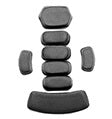
HHV COMFORT PLUS PADS
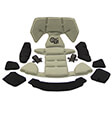
TEAM WENDY EPIC AIR™
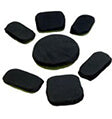
OREGON AERO SEVEN PAD BLU® KIT
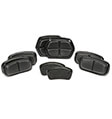
OPS-CORE EPP PAD
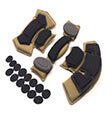
FMA PADS AMAZON
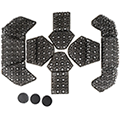
HHV MICRO LATTICE HELMET PADS
BOTTOM LINE
Quick and easy to install, the HHV Comfort Plus Pads make any helmet much more comfortable to wear especially for all day use.
Team Wendy is known for their aftermarket padding and retention systems. The EPIC AIR pad system really is epic in the sense that it provides users with lots of adjustability and comfort that fits most helmets.
Developed in 1997 for the U.S. Army Special Operation MICH helmet. These pads are simple and effective, but were not as comfortable as most other systems we tested.
These are the standard pads that come in most OPS-CORE helmets. They feature a hard styrofoam type base layer with a softer memory foam top layer. We found these pads to be somewhat hard, especially with the added weight of NVG's, etc.
Were initially comfortable to wear and use, but started falling apart after only a dozen or so hours of use. Does not come with any performance testing info. Not recommended for professional use without actual testing info.
These are the next evolution in tactical helmet pads. These micro lattice pads are not only are the most comfortable pads we have ever worn, but they also outperform any pads we have tested in terms of ballistic and blunt impacts. Created using a process called Digital Light Synthesis ™ they conform perfectly to your head.
PROS
Reasonable price, but still meets and exceeds all standards. The memory foam conforms to the individual user's skull creating a secure and comfortable fit.
Features an impact liner with integrated air channels for air flow and customizable comfort pads in two thicknesses to help get the perfect fit.
Includes 7 helmet liner pads of various sizes, simple to install, and easy to clean with mild soap and water.
They are unaffected by temperature, altitude, or moisture, and come with 8 pads per kit. Easily secures with VELCRO® to just about any helmet.
Cheap and you can buy them on Amazon! Would be just fine for Airsoft or any other use where actual blunt performance isn't needed.
Extremely comfortable and breathable. Easy to install and position inside the helmet. Superior protection during blunt and ballistic impacts. Extreme temperature swings do not degrade performance and are more fire-resistant than standard foam pads.
CONS
If users are not careful when re-positioning pads, the outer moisture-wicking fabric is easy to tear. Pads take a minute or two to soften up when used in cold temps.
Pad system will take more messing to get the right fit with trial and error. Pads are double in price than other options. Plastic air channels may rub on some users heads, but they do not have to be used.
Simply not as comfortable as other systems we tested.
They were comfortable for shorter-term use, but we found the closed cell foam they use for the comfort layer just didn't have enough material to keep things comfortable during a longer period of ware.
Cheaply made, and fell apart on us quickly. No testing data, and would not suggest using for professional use.
Higher cost than most foam-based pad options. It Will leave a funny mark on your forehead but does include a sweatband if you don't like this.
TESTING DATA
Tested with HHV ATE Helmet
Back-Face Deformation: Less Than 14mm
Blunt Impact: AR/PD 10-02 (AVG 72.6G)
Blunt Impact: AR/PD 10-02
Actual Data Not Published
No Actual Data Published, but the chart on their website looks to be under 75 g’s with blunt impact.
No Testing Data for the pads themselves found
No Testing Data
Back-Face Deformation: Averages as low as 4.41 mm over 5 shots
Blunt Impact AR/PD 10-02: Averages as low as 49.75G's over 14 drops.
Your Guide For Military Helmet Pads
Let's face it, most issued tactical helmet pads are uncomfortable and end up getting replaced. With so many options though, what's the best choice?
Afterall, we all talking about protecting one of your most vital organs and it's not something you want to make the wrong choice on.
You are looking for something that provides comfort for those long patrols or call-outs, but also the protection needed in case of impact.
Are the cheap helmet pads you found on Amazon good enough, or do you have to buy the most expensive ones on the market?
How We Decided
Each pads tested was purchased or borrowed, we never
accept anything from product manufacturers.

12
Models Tested

12
Experts Interviewed

12
Consumer Reviews
As usual here at Hard Head Veterans, we are naturally partial to our own tactical helmet pads, but we will be the first to admit that there are other great products out there. We kept this review as unbiased as possible. The research conducted to analyze and compare these pad systems was in depth and based not only off initial impressions and hard data, but also off of the experiences of numerous Special Operations members, Police Officers, and industry experts.
Ready to head out and purchase a set of new pads for your tactical helmet? Make sure to check out our matrix above for 6 different pad options and the pros and cons of each! If you are looking for additional information about shopping for a pad setup for your helmet, continue reading our shopping guide below.
There are lots of different helmet pad designs out there, but we will break them down into two types. Single-layer pad setups and multi-layer pad setups.
Each pad types have their pros and cons. Multi-layer helmet pad systems will provide a more custom fit, but also are more complex with additional set up time. While single layer ballistic helmet pad systems are quick and easy to set up, but may not give as custom of a fit.
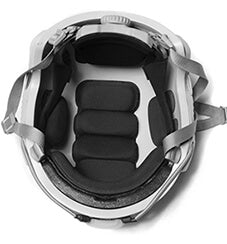
SINGLE-LAYER
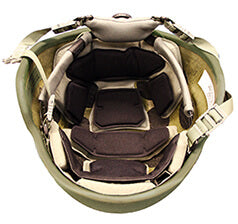
MULTI-LAYER
PRODUCT IN DEPTH
FMA Amazon Helmet Pads
Design Difference
These are advertised for Airsoft and would be perfectly suited for that we would think. Any other use we would recommend against. This is a multi-layer system that we got a pretty good fit with after some adjustment.
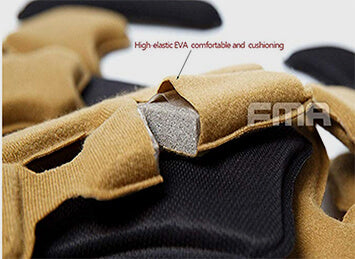
TACTICAL HELMET PAD TESTING
Test Types
The extreme importance of pad performance and set-up is often overlooked by many purchasers and you should not make that mistake. Quality helmet pads have to do much more than just be comfortable, they are the main line of defense during blunt and ballistic impacts after the tactical helmet shell itself. The two major tests we test for and like to see data on are the following. *Note that each pad setup will have slightly different performances with various companies shells, and even more variance if the fibers/layers used in the shell are different.
Backface Deformation 9mm (1400fps) BFD: Avg less then 25 mm all locations (front/back/crown/sides)
Blunt Impact Performance: (per AR/PD 10-02): Avg Less then 150g's over 14 drops
PRODUCT IN DEPTH
HHV Micro Lattice Pads
Features
Up to a 66% decrease in ballistic transient deformation over standard foam pads. Up to a 21.70% decrease in blunt impact accelerations over standard foam pads. Lattice construction allows unrestricted airflow keeping helmets an average of 14 degrees cooler
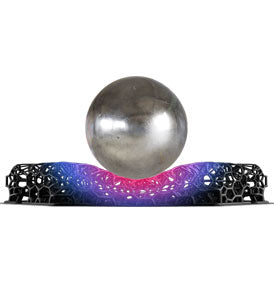
MULTI-LAYER TACTICAL HELMET PAD CONSIDERATIONS
Multi Layer
Through testing and your guy's questions, we discovered that many purchasers were not using the multiple pads in conjunction or layering them. These systems are designed to have an impact mitigating layer closes to the shell, and then another comfort layer, layered on top of the impact layer.
Viewing the video above that shows the multi-layer system that our ATE GEN2 comes standard with, you will get a better idea on what we mean by layering and adjusting for the ideal fit with the tactical helmet pads.
Most helmets used velcro discs on the inside of the helmet to allow the user to change out, modify, or re-position pads to get the very best fit.
TACTICAL HELMET PAD MATERIAL CONSIDERATIONS
Material Types
Material types of helmet pads range substantially and will perform different roles. Some materials used will focus more on comfortability while others may focus on impact mitigation.
Typical material types include foams, rubbers, plastics, and hybrid options.
Foams are most commonly used with tactical helmet pads and will include closed-cell/open-cell in polyester, polyurethane, polyethylene of varying densities.
Regardless of the material used for the inside of the pad itself, the exterior will typically be made of some type of thin fabric. Some companies will use a plastic liner between the fabric and foam to keep things waterproof/sweatproof.
PRODUCT IN DEPTH
OPS-CORE EPP Pads
Design Difference
These are advertised for Airsoft and would be perfectly suited for that we would think. Any other use we would recommend against. This is a multi-layer system that we got a pretty good fit with after some adjustment.
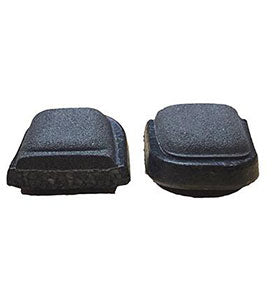
Did You Know?
Older generations of helmets such as the WW2 M1 helmet didn't even use pads? They used a suspension type system with varying results.
For Your Safety
Always try and keep any interior bolts or other hard components covered with your pad and retention system.
During blunt and ballistic impacts you want your skull coming in contact with pads before anything else.
PRODUCT IN DEPTH
Team Wendy EXFIL Ballistic Helmet
Retention System
Team Wendy Epic Air pad system takes a multi-layer approach. Systems like this are designed to have the pads layered to get optimal fitment for each individual's head shape. Most companies that offer this type of system include a different thickness of pads for the user to work with.
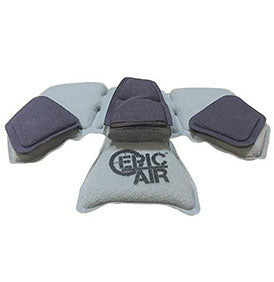
MULTI-LAYER TACTICAL HELMET PAD CONSIDERATIONS
Multi Layer
Through testing and your guy's questions, we discovered that many purchasers were not using the multiple pads in conjunction or layering them. These systems are designed to have an impact mitigating layer closes to the shell, and then another comfort layer, layered on top of the impact layer.
Viewing the video above that shows the multi-layer system that our ATE GEN2 comes standard with, you will get a better idea on what we mean by layering and adjusting for the ideal fit with the tactical helmet pads.
Most helmets used velcro discs on the inside of the helmet to allow the user to change out, modify, or re-position pads to get the very best fit.
PRODUCT IN DEPTH
Hard Head Veterans Comfort Plus Pads
Single-Layer Pads
This single-layer pad system utilizes 3 different layers within the pad itself to achieve premium comfortability and protection for users. Attaching via velcro they are easy to place or re-position.
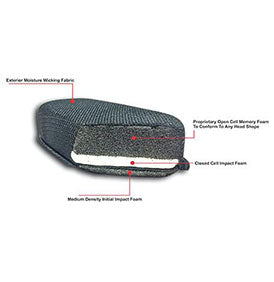
SINGLE-LAYER TACTICAL HELMET PAD CONSIDERATIONS
If you prefer simple and quick, we always suggest single layer type pad setups. They are easy to install and re-position to get the fit you need, without having to mess with multiple pads in different thicknesses.
Some companies will offer multiple thickness options for their single-layer pad setups that you can mix and match with as well.
With single-layer pad setups, especially with older issued pads, it's sometimes tempting to remove specific pads all together to get a more comfortable fit. We would strongly advise against this! Get smaller pads or switch them out with another system that fits.
TIPS AND TRICKS
Helmet pads are like boots, they will last a while if taken care of, but do need to be replaced from time to time. Just like boots, do this before they completely come apart and expect a short break in period.
Ensure that any tactical helmet pad system you purchase comes from a reputable company if you are using it to work. Ask how the pads have been tested.
You are going to sweat, get the pads filthy, and perhaps lose some hair to them. You can clean most fairly easily with mild soap and water! Helps with the smell as well.
Don't forget to play with the fitment, if you start developing a hot spot during use, try and adjust the pads some. While no system is ever going to be as comfortable without a helmet on, you should be able to wear one for hours on end without hot spots of headaches.
PRODUCT IN DEPTH
D3O Stealth Helmet Pads
Single-Layer Pads
Constructed using D3O’s newly engineered Decell material, the Stealth™ Helmet Pad System provides extreme comfort and high-performance protection, exceeding the required level of protection at 10ft/sec by 45% on average and maintaining consistent performance on second impact.
We have lab tested D30 pads in our own helmets and they perform great!

